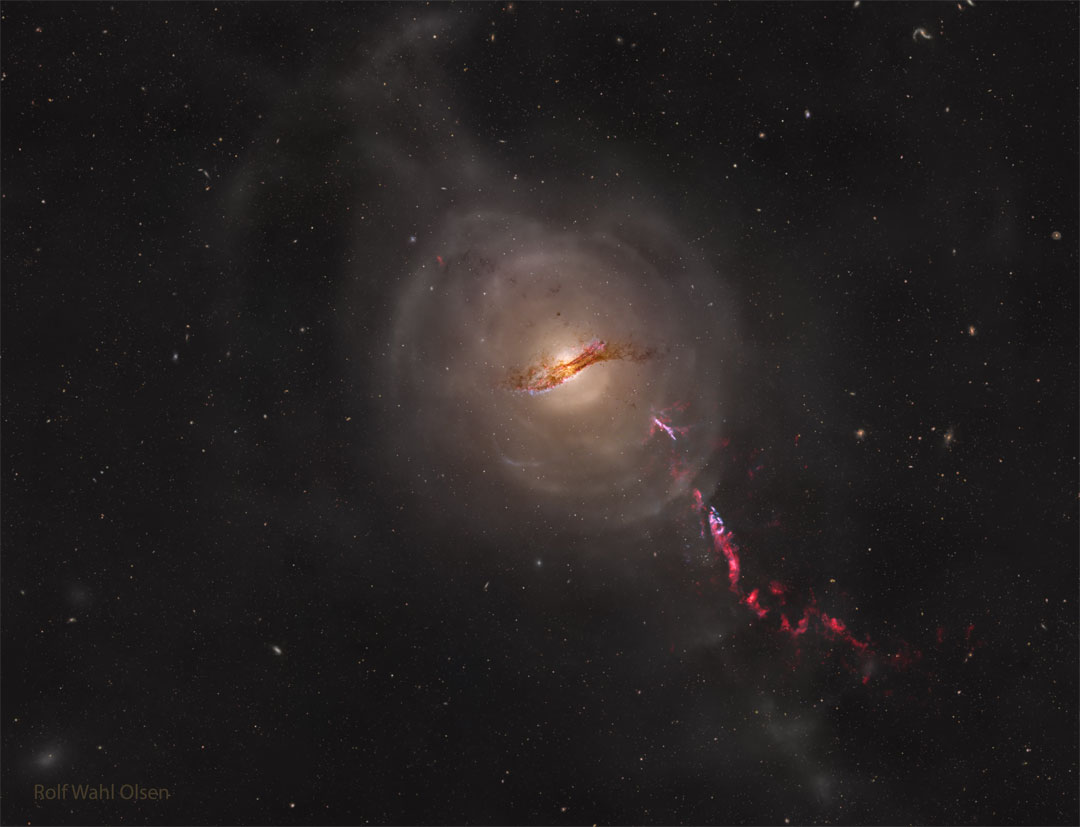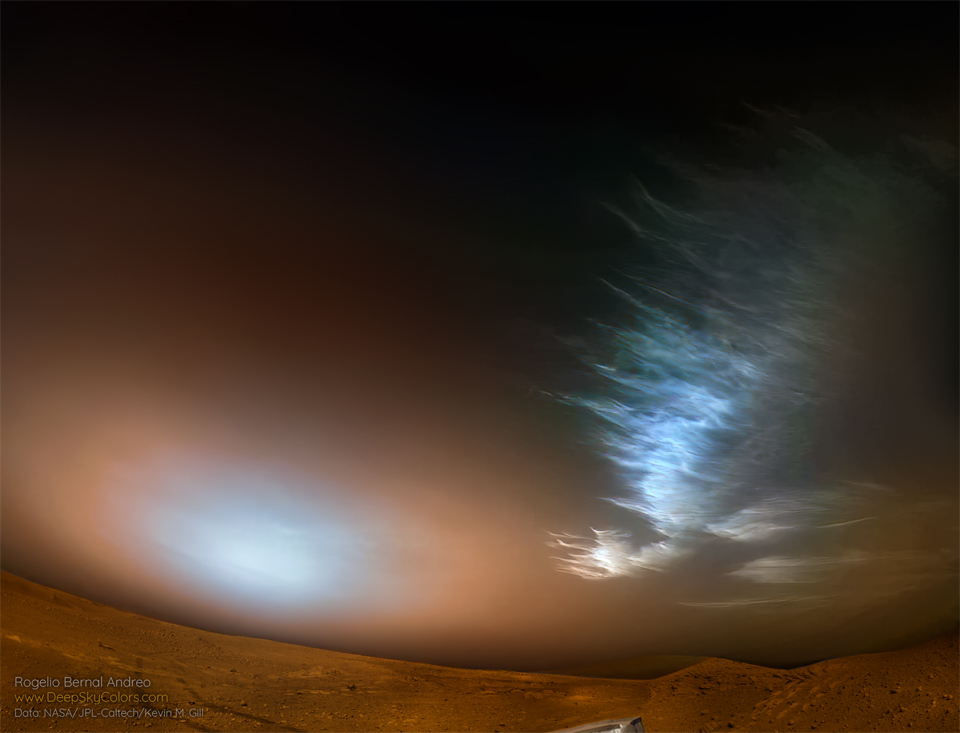Η Αστρονομική Εικόνα της Ημέρας από τη NASA
A Solstice Sun Tattoo
20/12/2025
The word solstice is from the Latin for Sun and to pause or stand still. And in the days surrounding a solstice the Sun's annual north-south drift in planet Earth's sky does slow down, pause, and then reverse direction. So near the solstice the daily path of the Sun through the sky really doesn't change much. In fact, near the December solstice, the Sun's consistent, low arc through northern hemisphere skies, along with low surface temperatures, has left a noticeable imprint on this path to the mountain town of Peaio in northern Italy. The morning frost on the road has melted away only where the sunlight was able to reach the ground. But it remains in the areas persistently shadowed by the fence, tattooing in frost an image of the fence on the asphalt surface.
Copyright: Marcella Pace
Προηγούμενες Αστρονομικές Εικόνες της Ημέρας από τη NASA
The Shells and Jets of Galaxy Centaurus A
11/12/2024
What's the closest active galaxy to planet Earth? That would be Centaurus A, cataloged as NGC 5128, which is only 12 million light-years distant. Forged in a collision of two otherwise normal galaxies, Centaurus A shows several distinctive features including a dark dust lane across its center, outer shells of stars and gas, and jets of particles shooting out from a supermassive black hole at its center. The featured image captures all of these in a composite series of visible light images totaling over 310 hours captured over the past 10 years with a homebuilt telescope operating in Auckland, New Zealand. The brightness of Cen A's center from low-energy radio waves to high-energy gamma rays underlies its designation as an active galaxy. Astrophysicists: Browse 3,500+ codes in the Astrophysics Source Code Library
Copyright: NASA
The Great Meteor Storm of 1833
10/12/2024
It was a night of 100,000 meteors. The Great Meteor Storm of 1833 was perhaps the most impressive meteor event in recent history. Best visible over eastern North America during the pre-dawn hours of November 13, many people -- including a young Abraham Lincoln -- were woken up to see the sky erupt in streaks and flashes. Hundreds of thousands of meteors blazed across the sky, seemingly pouring out of the constellation of the Lion (Leo). The featured image is a digitization of a wood engraving which itself was based on a painting from a first-person account. We know today that the Great Meteor Storm of 1833 was caused by the Earth moving through a dense part of the dust trail expelled from Comet Tempel-Tuttle. The Earth moves through this dust stream every November during the Leonid meteor shower. Later this week you might get a slight taste of the intensity of that 1833 meteor storm by witnessing the annual Geminid meteor shower. Explore Your Universe: Random APOD Generator
Copyright: NASA
Pleiades: The Seven Sisters Star Cluster
09/12/2024
Have you ever seen the Pleiades star cluster? Even if you have, you probably have never seen it as large and clear as this. Perhaps the most famous star cluster on the sky, the bright stars of the Pleiades can be seen with the unaided eye even from the depths of a light-polluted city. With a long exposure from a dark location, though, the dust cloud surrounding the Pleiades star cluster becomes very evident. The featured 23-hour exposure, taken from Fagagna, Italy covers a sky area several times the size of the full moon. Also known as the Seven Sisters and M45, the Pleiades lies about 400 light years away toward the constellation of the Bull (Taurus). A common legend with a modern twist is that one of the brighter stars faded since the cluster was named, leaving only six of the sister stars visible to the unaided eye. The actual number of Pleiades stars visible, however, may be more or less than seven, depending on the darkness of the surrounding sky and the clarity of the observer's eyesight. New: Alternative multi-APOD front page
Copyright: Francesco Pelizzo
Aurora around Saturn's North Pole
08/12/2024
Are Saturn's auroras like Earth's? To help answer this question, the Hubble Space Telescope and the Cassini spacecraft monitored Saturn's North Pole simultaneously during Cassini's final orbits around the gas giant in September 2017. During this time, Saturn's tilt caused its North Pole to be clearly visible from Earth. The featured image is a composite of ultraviolet images of auroras and optical images of Saturn's clouds and rings, all taken by Hubble. Like on Earth, Saturn's northern auroras can make total or partial rings around the pole. Unlike on Earth, however, Saturn's auroras are frequently spirals -- and more likely to peak in brightness just before midnight and dawn. In contrast to Jupiter's auroras, Saturn's auroras appear better related to connecting Saturn's internal magnetic field to the nearby, variable, solar wind. Saturn's southern auroras were similarly imaged back in 2004 when the planet's South Pole was clearly visible to Earth. Your Sky Surprise: What picture did APOD feature on your birthday? (post 1995)
Copyright: NASA
Rocket Engine Fireplace
07/12/2024
You might not think a close up view of rocket engines producing 8.8 million pounds of thrust would be relaxing, but here it can be. In fact, you can get a warm and cozy feeling just spending a few moments watching NASA's holiday rocket engine fireplace. The video features a loop of the Space Launch System rocket's RS-25 main engines throttled up and running flanked by solid rocket boosters and framed by a stone fireplace. The accompanying audio track mixes the drastically muted sounds of the rocket engines firing with the more familiar sounds of a burning, crackling wood fire. AI elements are included in the composed video along with an image and logo from the Artemis I mission. The Artemis I uncrewed mission to the Moon and back again launched in November 2022 on a Space Launch System rocket.
Copyright: NASA
Xuyi Station and the Fireball
06/12/2024
Colorful and bright, this streaking fireball meteor was captured in a single exposure taken at Purple Mountain (Tsuchinshan) Observatory’s Xuyi Station in 2020, during planet Earth's annual Perseid meteor shower. The dome in the foreground houses the China Near Earth Object Survey Telescope (CNEOST), the largest multi-purpose Schmidt telescope in China. Located in Xuyi County, Jiangsu Province, the station began its operation as an extension of China's Purple Mountain Observatory in 2006. Darling of planet Earth's night skies in 2024, the bright comet designated Tsuchinshan-ATLAS (C/2023 A3) was discovered in images taken there on 2023 January 9. The discovery is jointly credited to NASA's ATLAS robotic survey telescope at Sutherland Observatory, South Africa. Other comet discoveries associated with the historic Purple Mountain Observatory and bearing the observatory's transliterated Mandarin name include periodic comets 60/P Tsuchinshan and 62/P Tsuchinshan.
Copyright: Purple Mountain (Tsuchinshan)
Stereo Jupiter near Opposition
05/12/2024
Jupiter looks sharp in these two rooftop telescope images. Both were captured last year on November 17 from Singapore, planet Earth, about two weeks after Jupiter's 2023 opposition. Climbing high in midnight skies the giant planet was a mere 33.4 light-minutes from Singapore. That's about 4 astronomical units away. Jupiter's planet girdling dark belts and light zones are visible in remarkable detail, along with the giant world's whitish oval vortices. Its signature Great Red Spot is prominent in the south. Jupiter rotates rapidly on its axis once every 10 hours. So, based on video frames taken only 15 minutes apart, these images form a stereo pair. Look at the center of the pair and cross your eyes until the separate images come together to see the 3D effect. Of course Jupiter is now not far from its 2024 opposition. Planet Earth is set to pass between the Solar System's ruling gas giant and the Sun on December 7.
Copyright: Marco Lorenzi
Ice Clouds over a Red Planet
03/12/2024
If you could stand on Mars -- what might you see? You might look out over a vast orange landscape covered with rocks under a dusty orange sky, with a blue-tinted Sun setting over the horizon, and odd-shaped water clouds hovering high overhead. This was just the view captured last March by NASA's rolling explorer, Perseverance. The orange coloring is caused by rusted iron in the Martian dirt, some of which is small enough to be swept up by winds into the atmosphere. The blue tint near the setting Sun is caused by blue light being preferentially scattered out from the Sun by the floating dust. The light-colored clouds on the right are likely composed of water-ice and appear high in the Martian atmosphere. The shapes of some of these clouds are unusual for Earth and remain a topic of research.
Copyright: NASA
Η Αστρονομική Εικόνα της Ημέρας από τη NASA (NASA Astronomy Picture of the Day) είναι μια δωρεάν υπηρεσία που παρέχει καθημερινά μια εντυπωσιακή εικόνα από το σύμπαν, την λήψη της οποίας έχει πραγματοποιήσει κάποιος από τους αστρονόμους της NASA ή από κάποιον από τους δορυφόρους ή τα τηλεσκόπια που η NASA λειτουργεί. Οι εικόνες που εμφανίζονται καλύπτουν μια ευρεία γκάμα από θέματα, συμπεριλαμβανομένων των αστερισμών, των γαλαξιών, των πλανητικών συστημάτων, των κομητών, των αστρικών σωμάτων και των παρατηρητηρίων. Κάθε εικόνα συνοδεύεται από μια σύντομη εξήγηση και πληροφορίες σχετικά με το τι παρατηρείται στην εικόνα.








